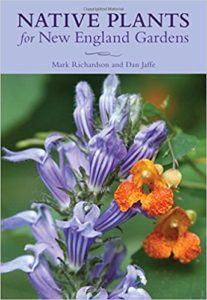Category Archives: Horticulture
Sharpen the Saw at the 27th Ecological Landscape Alliance Conference & Eco-Marketplace: March 3-4
What to do for your habitat and pollinator gardens this winter? It’s learning season!
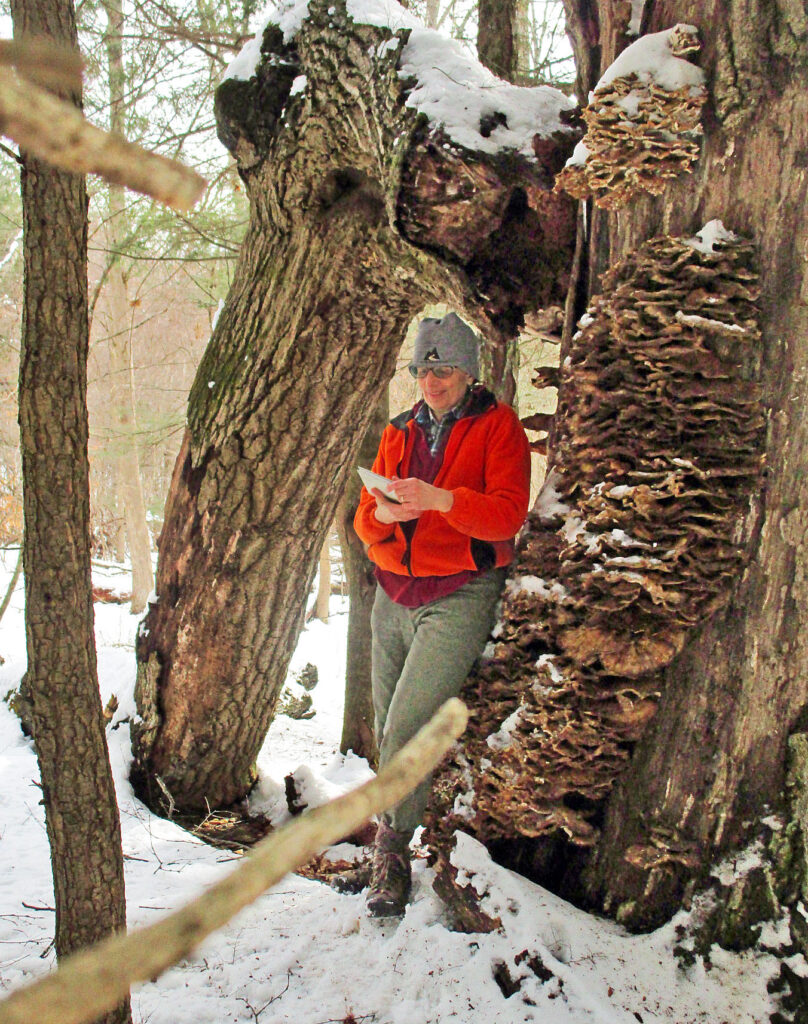
Garden-911 Boston owner Carol Lundeen learns to estimate the age of an old growth northern red oak tree. Since the actual age of trees cannot be determined without cutting the trunk and counting its individual growth rings – or by using a core boring tool – she instead used her outstretched arms as a measuring tape to estimate its circumference, which was more than three times her reach. Dividing the circumference by pi (approx 3.14), she arrived at the DBH (diameter at breast height). Using an arborist multiplication factor specific to northern red oaks, she estimated that this Quercus rubra lived for about 265 years old before its growth potential, environmental and cultural factors brought on its demise – though it’s now continuing the cycle of life by being home to walls of fungi, birds, insects and other wildlife.
Nothing like having something inspiring to look forward to during a pandemic – like learning! The Ecological Landscape Alliance’s 27th Conference and Eco-Marketplace lights up my calendar on March 3-4 and I can’t wait to sample the design, climate change/resilience and inclusion tracks. Below are the top ten talks I’ve circled so far. For more info, visit https://www.ecolandscaping.org – I hope to see you there!
Learn about top new trends in native plant and pollinator gardens, design and consulting:
- Toby Wolf, Wolf Landscape Architecture: “Sharing the Adventure: Design Communications for Ecological Landscapes”
- Gerdo Aquino, SWA Group: “The Aesthetics of Ecology and Why Design Matters”
- Nadia Malarkey, Nadia Malarkey Design: “Regenerating Suburbia One Garden at a Time”
- Lisa Hayden, New England Forestry Foundation: “Engaging Landowners in Sustainable Stewardship”
- Leah Penniman, Soul Fire FarmFarming While Black: “African ” Wisdom for Farming and Food Justice”
- Ryan Serrano, Earth Steward Ecology Inc: “Regenerative Landscape Essentials: Tethering Function and Aesthetic
- Pamela Conrad, CMG Landscape ArchitectureClimate Positive Design – Going Beyond Neutral
- Dan Jaffe Wilder, Norcross Wildlife Sanctuary: “Taking on the Big Places: How to Build and Maintain Self-Sufficient Landscapes”
- Thursday’s Luncheon Discussion: “Diversity, Equity, and Inclusion in Horticulture”
- Anna Fialkoff, Wild Seed Project: “Rewild in 10 Action Steps
About the ELA (Ecological Landscape Alliance)
Here’s the scoop on the ELA, of which I’m a member, quoted from the ELA website:
“Since its founding in 1992, the Ecological Landscape Alliance has been a leader in promoting sustainable approaches to landscape design, construction, and management. ELA’s commitment to innovative ideas and evidence-based practices has made the organization both a trusted resource and a vibrant community of landscape professionals and devoted gardeners.
Our Mission
The Ecological Landscape Alliance advocates for ecological landscape practices through education, collaboration, and outreach.
Our Vision
Everyone who interacts with the land is a steward whose actions are informed by an understanding of and respect for natural systems.”
For more info visit https://www.ecolandscaping.org
THE WONDER OF PLANT ADAPTATIONS at NATIVE PLANT TRUST
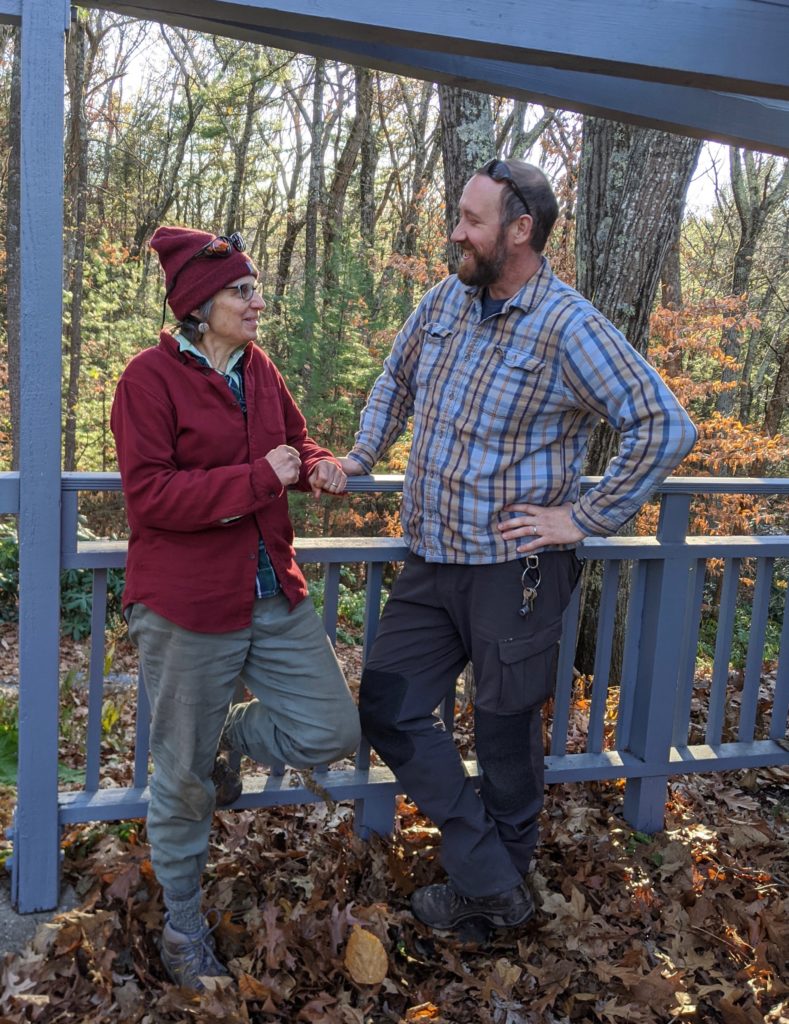
Carol Lundeen with Native Plant Trust Director of Horticulture Uli Lorimer outside the Trust’s education building after his Plant Adaptations class at the Trust in Framingham, MA. Lorimer demonstrated how every feature of a plant is a result of an adaptation designed to afford reproductive, environmental or cultural success.
The magic of botany. If you love botany, or appreciate nature, you would have loved Uli Lorimer’s Plant Adaptations class at Native Plant Trust. Right down to the molecular level, every feature of a plant is a result of an adaptation designed to afford reproductive, environmental or cultural success. This class explored the myriad ways plants have adapted to different habitats, soil types, pollination and dispersal schemes while co-evolving with other organisms in shared, co-dependent ecosystems.
Some adaptations may make it very difficult for a plant to survive in different environments, cultural and/or ecological conditions than those in which it evolved over time, which is why climate change makes it so difficult for some plants that their populations and distributions have declined, and some are vulnerable to extinction. Other plants are able to thrive and reproduce in a wide variety of situations, and so can overcome and replace vulnerable populations.
Native Plant Trust’s mission is to conserve and promote New England’s native plants to ensure healthy, biologically diverse landscapes, and vision is that through their leadership, New England’s native plants will exist in vigorous populations within healthy, evolving ecosystems, and people across the region will actively promote and protect them in the wild and in their gardens.
As Director of Horticulture at Native Plant Trust, Lorimer oversees Garden in the Woods, a botanic garden in Framingham, MA, and Nasami Farm in western MA, a nursery focused on propagation of and research about New England native plants.
SUSTAINABLE LAWNS, HEALTHY LANDSCAPES, WETLANDS AND WATER RESOURCES
What’s so great about a great lawn?
- Do you want a lawn that looks like a lush golf course? It’s going to cost you…and your neighbors, your town’s water quality and other natural resources. The typical best-in-the-neighborhood MA lawns are a mix of bluegrass, rye and fescue turf grasses. These are all cool season, non-native grasses that do not naturally do well here in our summer heat and droughts; these lawns need lots of time, energy and money to look as good as they do for as long as they do.
- The conventional practice is to follow the conventional high-input “advice” of landscape chemical companies’ and landscape vendors’ marketing efforts, including expensive fertilizer, insect and weed killers, bacteria and fungus killers, plus frequent mowing and watering.
- Your resulting “chem” lawn may look good, but it has negative and potentially hazardous impacts on your health and that of others; your wallet and that of others; and the wetland and ecosystems that filter pollutants from your water and mitigates flood damage, pollinates your food (everything we eat was once a plant), and provides natural settings for recreation and relaxation for you and others—among many other free but essential life services.
- Add it all up and you may realize what many others already know: that a “chem” lawn is actually more expensive and damaging than you ever thought. So ask yourself, “Is it really worth working and paying for a perfect lawn?” “Why should I care?” and, “What are healthier alternatives that save me money and time?”
What’s a sustainable lawn and why would it benefit you?
-
- SOIL AND WATER: Turf grasses naturally want to send their roots down about 6-12 inches into loamy topsoil that contains about 10% organic matter, such as compost. Established lawns want to be watered deeply (one inch of water) once a week, or one inch twice during hot weather. That way, their roots never dry out for extended periods and thus they don’t go into summer brownout/dormancy. Most irrigation systems are not programmed to water lawns on this kind of schedule. Instead, most water lightly several times a week, never delivering enough water to penetrate fully to the whole root system, so the water is largely wasted. What if you don’t have appropriate soil to support a robust lawn? See three bullet points below.
- TEST YOUR WATERING SYSTEM: You want one inch of water per week for established laws, so how do you find out how much water is actually being delivered? Before you turn on your sprinkler or your irrigation system comes on, put out a bunch of clean cat food or tuna fish cans to collect water. (Ask your friends and neighbors if you don’t have your own supply). After the system runs, use a ruler to measure how much water is in each can. If it’s not a little over an inch—the ruler will displace some water and increase the reading on the ruler—increase the run time and test again. Repeat adjustments until you get about an inch.
- SOIL TESTING: Get your soil tested to find out what kind of soil you have, your pH, your organic matter, and what amendments you can add to make your soil more ideal for your turf grasses. The most crucial part of soil testing is getting a truly representative sample. UMass has easy to follow recommendations for soil sampling, and they test soil for a reasonable fee. Learn more at https://ag.umass.edu/services/soil-plant-nutrient-testing-laboratory
- IF YOU DON’T HAVE IDEAL SOIL:
- Follow the recommendations from your soil test.
- Adjust your expectations and know that any lawn is a living work in progress.
- Good or poor soil, add ¼ to ½ inch of compost to your lawn every year late in the fall, after your last mowing. Over the winter it will improve your soil quality and improve lawn health. Do this every year, along with allowing your mowed grass clippings to fall and decompose in place, and you will not need to spend time and money fertilizing.
- Lime in the fall only if your soil test results call for it.
- If you feel you must fertilize, NEVER FERTILIZE WITHIN 100 FEET OF A WETLAND, VERNAL POOL OR POTENTIAL VERNAL POOL (or according to your local bylaw specifications). Beyond 100 feet (or according to your local bylaw specifications) of a wetland, vernal pool or potential vernal pool, apply an organic, slow release fertilizer just one time—and never just before or during a heavy rain—to your lawn between April 15th and October 15th. Limit that application to a maximum of 1 pound of nitrogen per 1000 square feet.
Organic fertilizers have non-water soluble nitrogen that releases to the soil at a steady rate over time. They help to build a healthy soil food web, as compared with conventional chemical fertilizers which are water soluble and result in nutrients (and your money) washing away as pollution into our waterways before they’re needed by your plants. A couple of readily available organic fertilizers are Espoma Garden-tone and Espoma Plant-tone. These are typically made of ground up feathers and bones rather than conventional petrochemicals. - Consider lawn alternatives
- Instead of turf grasses, use native, low-input sedges. Pennsylvania sedge, for instance, needs mowing only once a year and is drought tolerant after getting established.
- Add white clover to your lawn seed mix. Clover moves nitrogen from the soil to the ground and makes it available to green up your lawn
- Turn part of your lawn into an ornamental planting bed. Include native plants that are well adapted to our native soils. If well planned and designed, you’ll be saving time and money, supporting pollinators, improving water quality and the environment.
- SUN: Pay close attention to how many hours of mid-day sun each area of your lawn gets. Get a high quality grass seed mix to match the sun exposure. You can do many things to improve your soil—but changing the amount of sun your lawn gets is usually a bigger undertaking.
- MOWING: Set your mower to cut no lower than three inches. Use a mulching blade and let the clippings fall onto the lawn, where their nutrients will recycle right back into your soil, increasing your soil’s organic matter for free. Also, save time and money by not raking your leaves in the fall. Just mow them with a mulching blade and without a grass catcher, and leave them to in place to decompose. Again, free organic matter. Note: If mowing leaves a thick layer of leaves, though, spread them out with a rake so the grasses can still get some sun.
- WEEDS: Weeds don’t stand a chance if your turf grasses are robust, aka appropriate for where they’re growing and therefore nice and dense; grown in good deep soil with proper nutrients, organic matter, soil chemistry, water and sun.
- INSECTS: Most insects, approximately 99% by number of species, are native insects that play a crucial role in the food web that supports our environment, that in turn supports people. Properly identifying and learning the life cycle of pests is the most important step in managing them. Many are beneficial. If you don’t want to learn about it, get help from a natural or organic horticulturist to learn if you have a normal amount of bugs or an infestation that needs management.
- BACTERIAL AND FUNGAL CONDITIONS: Most bacterial and fungal conditions in lawns occur because the lawn’s cultural conditions—including soil nutrients, pH and organic matter; sun exposure and water—do not favor a robust lawn planted with non-native, cool season grass species. You can spend lots of hazardous chemical resources and still not get the results you want.
- AERATING YOUR LAWN: Most lawns do not need to be aerated annually. Lawn areas that have high traffic have compacted soils that make it very difficult for grasses to thrive. Most of us are familiar with the fact that plants take in carbon dioxide and release oxygen, but this is only what the plant does above ground. Plants’ roots do the opposite, taking oxygen from the tiny spaces between tiny soil particles. If the lawn soil is compacted or constantly wet, your turf grasses’ roots cannot get the oxygen they need to thrive, and the above-ground portion of the grasses will not do well. If you choose to aerate, do not use any device with a solid spike shape, as these will only compact your soil further. Instead, use a tool or machine that has cylindrical-shaped fittings that will remove plugs of soil. These greatly reduce compaction and bring oxygen into the soil for the roots.
- WHEN TO TOP DRESS OR INSTALL A NEW LAWN: The single best time by far is September, for a long list of reasons.
- ADDITIONAL RESOURCES:
-
- Do not use Wikipedia
- Use the site that searches only state extension service sites that provide peer-reviewed scientific information: https://impact.extension.org/search/
- Town of Falmouth, MA Healthy Lawns, Health Waterways document on how to grow a healthy lawn without fertilizer: http://www.falmouthmass.us/DocumentCenter/View/950/Fertilizer-Facts—Falmouths-Nitrogen-Control-Bylaw-PDF?bidId=
-
TWO CHICKADEES WALK INTO A BAR…IN A SHARON FOREST
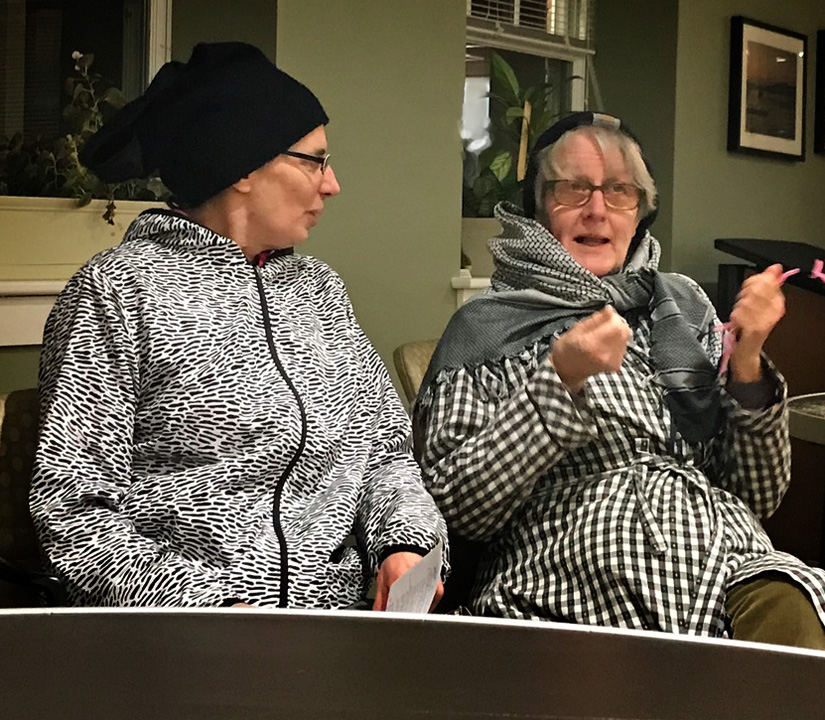
Sharon Garden Club January 2019 program “Wanted Dead: Not Alive!” presenters Carol Lundeen, left, and Brenda Minihan take the role of a pair of black-capped chickadees in a skit that tells the tale of how the introduction of beautiful exotic invasive plants by early American landscape designers has had terribly destructive results for native wildlife and our local, regional, and national natural resources. Ellen Schoenfeld-Beeks, not pictured, played the role of landscape designer “Fredericka” Law Olmstead in introducing the exotic plants to our country. Photo courtesy Marcia Podlisny.
.
GRADUATION DAY from the NEW ENGLAND WILDFLOWER SOCIETY!
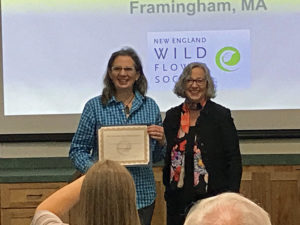
Carol Lundeen graduates from the New England Wildflower Society with an Advanced Certificate in Native Plant Horticulture an Design on November 3, 2018. Executive Director Debbi Edelstein presents Carol with her certificate.
One of my passions is lifelong learning, and another is to help people — and plants — who appreciate sustainable garden design and maintenance. I’m proud to have continued my studies at the New England Wildflower Society and earned an Advanced Certificate in Native Plant Horticulture an Design.
Each graduate had the opportunity to make a presentation about the required community service aspect of their certificate. I was proud to share my story of one of the two eyesore sites that I re-designed (and helped to install) at the Easton Town Offices that had been long overdue for a landscape makeover.

Easton MA Town Offices traffic circle landscape makeover by the Easton Garden Club. Several civic sites in Easton had become eyesores, and the Easton Garden Club collaborated with the community to sponsor a Design Challenge to spur interest in giving the sites a landscape makeover. Blueview Nurseries of Norton donated prizes. Garden club member and Garden-911 Boston owner Carol Lundeen re-designed this site, and it was installed with the town’s robust support.
I’m excited to continue to be a valuable resource in my community. While I currently serve as Horticulture Co-Chair with both the Sharon and Easton, MA garden clubs, I look forward to future opportunities to collaborate, create and educate people about smart, sustainable landscapes.
TOP 100 NATIVE PLANTS FOR NEW ENGLAND GARDENS
Congratulations to Mark Richardson and Dan Jaffe on publishing their extensive observations and close up photographs of their top 100 New England native plants. I’ve studied with them dozens of times while earning a certificate in native plant horticulture and design at the New England Wildflower Society’s Garden in the Woods in Framingham, MA and I think of them as native plant rock stars.
Mark is Botanic Garden Director, and Dan propagator and stock bed grower at Garden in the Woods.
LESSONS LEARNED WHEN FIELD BOTANY MEETS DESIGN – MARCH 7
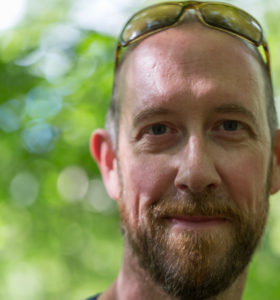
Uli Lorimer, Curator of the Native Flora Garden at Brooklyn Botanic Garden, will present Lessons Learned When Field Botany Meets Design at Grow Native Massachusetts’ Evenings with Experts lecture series at the Cambridge Public Library, Wednesday March 7 from 7:00 – 8:30 pm.
Evenings with Experts | Uli Lorimer | March 7 | Grow Native Massachusetts | Cambridge Public Library
Uli Lorimer, Curator of the Native Flora Garden at Brooklyn Botanic Garden
Ecologically attuned designers are increasingly looking to nature for inspiration in the design of managed landscapes. But connecting field botany to horticulture is complex, and insights gained from observations in the wild don’t always translate directly into a cultivated garden.
Uli will use the recently expanded native flora garden at Brooklyn Botanic Garden, a cultivated pine barrens and coastal plain grassland, as a case study— sharing lessons learned along the way as the project evolved from a concept into a dynamic, living landscape. Good design allows for change and succession to occur, and flexibility in design intent is a valuable strategy because things do not always work out as planned.
Uli Lorimer has been the Curator of Native Flora at the Brooklyn Botanic Garden Garden for over a decade. He was instrumental in the expansion of the Garden’s native plant collection, using only material sourced from the wild and grown from seed. As Field Chair at BBG, he coordinates fieldwork with regional botanists and leads botanical expeditions for naturalists and horticulturists.
This lecture is co-sponsored by Mount Auburn Cemetery
HAPPY HOLIDAYS FROM NORTH EASTON, MA
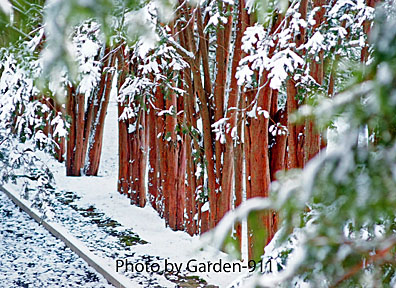
Here’s my favorite view of a secluded gallery of mature Taxus trees on The Trustees of Reservations’ Governor Oliver Ames Estate in North Easton, MA. The 36-acre property features rolling hills, meadows, ponds, and a robust horticulture collection. The Ames familys industrial and cultural contributions have helped shape the history of Easton, as well as the nation, since the early 19th century.
WANTED: DEAD NOT ALIVE Invasive Plants Exhibit Wins Educational Excellence Award
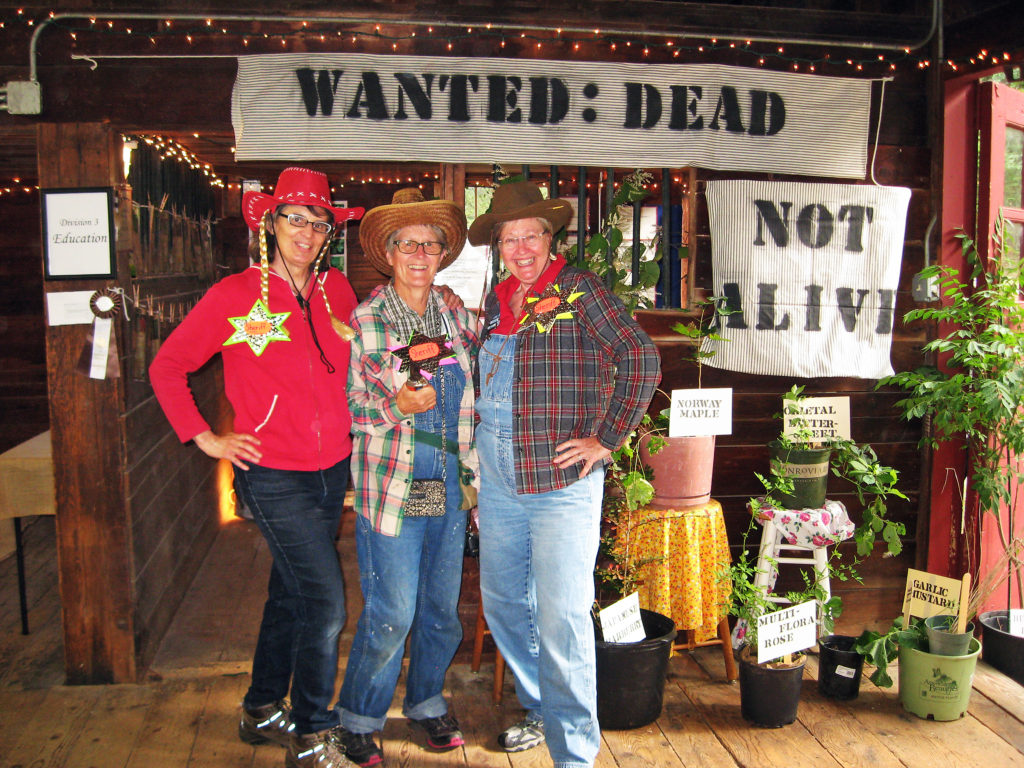
WANTED: DEAD NOT ALIVE received an Educational Excellence award at the Sharon Garden Club’s September Garden Medley on September 9, 2017. The exhibit featured potted exotic invasive plants and illustrated some of the environmental damage they cause. Left to right are Carol Lundeen of Easton and Brenda Minihan and Ellen Schoenfeld-Beeks of Sharon. The trio played roles as invasive plant sheriffs, engaging visitors in conversation and offering invasive plant checklists, images, and ideas for native plant alternatives. Photo by Carol Lundeen.
WANTED: DEAD NOT ALIVE received an Educational Excellence award at the Sharon Garden Club’s September Garden Medley on September 9, 2017. The exhibit featured potted exotic invasive plants and illustrated some of the environmental damage that invasives cause. Carol Lundeen of Easton and Brenda Minihan and Ellen Schoenfeld-Beeks of Sharon played roles as invasive plant sheriffs, engaging visitors in conversation and offering invasive plant checklists, images, and ideas for native plant alternatives.
Exotic invasive plants have no natural predators and diseases that would naturally control their growth. Some invasive plants have escaped from our home gardens and public plantings into natural areas and cause profound environmental and economic damage. Massachusetts has developed a list of problematic plants. Some are even illegal to sell, including Norway maple, Japanese maple, burning bush, all hollow-stemmed honeysuckles, garlic mustard, oriental bittersweet, and Japanese knotweed.
The exhibit also included a “Talking Tree,” a young pin oak tree that posed the question, “When I turn one hundred years old, what do you hope I will say?” Visitors then wrote their answers on a card and tied their card to the tree with yarn. The tree will be planted at the Unitarian Universalist Church in the center of Sharon.
The sheriffs urge folks to learn about the species considered invasive in the area, generate a list of those on your property or in your town, create a plan for eliminating them, and execute your plan. Contact the Sharon Garden Club or Carol Lundeen for further information.

